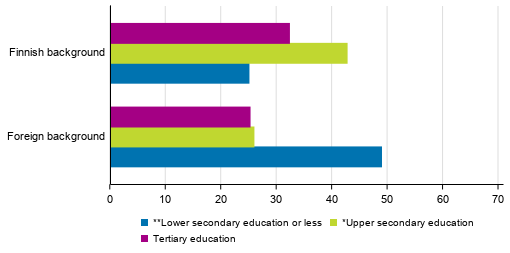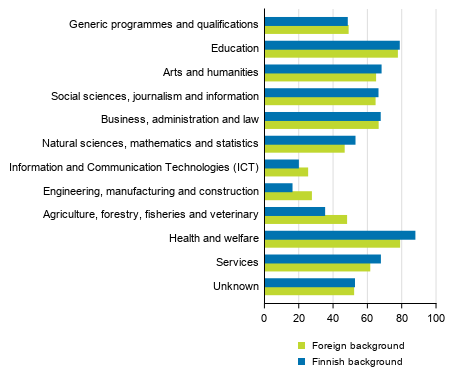Published: 5 November 2019
At least one-fourth of persons with foreign background had completed tertiary level qualifications
By the end of 2018, altogether 3,399,532 persons, or 73 per cent of the population aged 15 or over had completed a post-comprehensive level qualification. The share of persons with an educational qualification grew by one percentage point from the year before. Seventy-six per cent of the population with Finnish background had completed post-comprehensive level qualifications, while the corresponding share for persons with foreign background was 51 per cent.
Population by origin and level of education 2018

**Includes persons, whose qualifications attained abroad are not known
*Includes specialist vocational qualifications
Thirty-six per cent of the population with Finnish background had completed a tertiary level qualification in 2018. Overall, 40 per cent of the population with Finnish background had completed upper secondary level qualifications and 24 per cent were without a post-comprehensive level qualification. Twenty-five per cent of the population with foreign background had completed tertiary level qualifications. Overall, 25 per cent had completed upper secondary level qualifications and 49 per cent were without a post-comprehensive level qualification. Statistics Finland’s Register of Completed Education and Degrees has been complemented with qualifications attained abroad, but the Register still does not cover all qualifications attained abroad. The group with no post-comprehensive level qualifications also includes persons whose qualifications attained abroad are not known.
Population by origin, level of education and gender 2018
| Finnish background | Foreign background | |||||||
| Men | Women | Men | Women | |||||
| % | % | % | % | |||||
| Population aged 15 or over total | 2 104 897 | 100,0 | 2 206 820 | 100,0 | 167 149 | 100,0 | 156 819 | 100,0 |
| Lower secondary education or less | 543 599 | 25,8 | 534 085 | 24,2 | 89 228 | 53,4 | 69 241 | 44,2 |
| A post comprehensive level qualification total | 1 561 298 | 74,2 | 1 672 735 | 75,8 | 77 921 | 46,6 | 87 578 | 55,8 |
| Upper secondary educatiion | 971 637 | 46,2 | 871 079 | 39,5 | 40 879 | 24,5 | 42 929 | 27,4 |
| Tertiary education total | 589 661 | 28,0 | 801 656 | 36,3 | 37 042 | 22,2 | 44 649 | 28,5 |
| Lowest level tertiary education | 162 319 | 7,7 | 260 346 | 11,8 | 3 540 | 2,1 | 5 776 | 3,7 |
| Bachelor’s or equivalent level | 222 587 | 10,6 | 287 024 | 13,0 | 14 407 | 8,6 | 18 005 | 11,5 |
| Master’s or equivalent level | 181 648 | 8,6 | 234 937 | 10,6 | 15 302 | 9,2 | 18 610 | 11,9 |
| Doctoral or equivalent level | 23 107 | 1,1 | 19 349 | 0,9 | 3 793 | 2,3 | 2 258 | 1,4 |
Twenty-four per cent of women with Finnish background were without post-comprehensive level qualifications, while the corresponding share for men was 26 per cent. Women’s higher level of education than men’s was clearly visible when it came to persons with tertiary level qualifications. Thirty-six per cent of women had completed tertiary level qualifications, while the corresponding share for men was 28 per cent. Men completed a licentiate or doctorate level degree more often than women. Among men, 1.1 per cent completed doctorate level qualifications and among women 0.9 per cent.
The educational structure of the population with foreign background is very similar to that of the population with Finnish background when examined in light of gender. Forty-four per cent of women were without post-comprehensive level qualifications or there were no qualification data, while the corresponding share for men was 53 per cent. Twenty-nine per cent of women had completed tertiary level qualifications and so had 22 per cent of men. Men of foreign background completed doctorate level qualifications more than women. Among men, 2.3 per cent completed doctorate level education and among women 1.4 per cent.
The database tables describe the shares and numbers of those with qualifications examined by gender, age group and area.
Population with qualifications by origin and field of education in 2018, women %

In 2018, the fields of education were segregated by gender in both the population with Finnish background and the population with foreign background. The traditionally male-dominated fields were male-dominated also among the population with foreign background, even though the segregation was more moderate than among the population with Finnish background. Of the population with Finnish background having completed degrees or qualifications in the field of technology, the share of women was 16 per cent, while the share of women of persons with foreign background having completed degrees of qualifications in the field of technology was 27 per cent. Of the population with Finnish background having completed degrees or qualifications in the field of health and welfare, the share of women was 87 per cent, whereas the share of women of foreign background of persons having completed degrees or qualifications in health and welfare was 79 per cent.
Population by the measure of level of education based on length of education in 2018

The highest educated population lived in Uusimaa in 2018. The population's measure of level of education indicates the average length of the highest level of completed education per capita. In Uusimaa, the population had completed an average of 4.2 years of post-comprehensive level education. The second highest educated population lived in Pirkanmaa, where the population had completed an average of 3.9 years of post-comprehensive level education. The level of education was lowest in the region of South Savo, where the population had completed an average of 3.2 years of post-comprehensive level education.
In 2018, there were 102,673 persons aged 20 to 29 with only basic level education, making up 15 per cent of the age group. Among men, 17 per cent of the age group had only basic level education and 13 per cent among women. The number of persons aged 20 to 29 with only basic level education was highest in ┼land, where 22 per cent of the age group had no post-comprehensive level qualification. The share of persons with only basic level education was lowest in North Karelia, South Ostrobothnia, Kainuu, Central Finland and North Savo, where 12 per cent of persons aged 20 to 29 had no post-comprehensive level qualifications.
Source: Education 2018. Statistics Finland
Inquiries: Mika Witting 029 551 3571, koulutustilastot@stat.fi
Director in charge: Jari Tarkoma
Publication in pdf-format (272.7 kB)
- Tables
-
Tables in databases
Pick the data you need into tables, view the data as graphs, or download the data for your use.
Appendix tables
Updated 5.11.2019
Official Statistics of Finland (OSF):
Educational structure of population [e-publication].
ISSN=2242-2919. 2018. Helsinki: Statistics Finland [referred: 19.4.2025].
Access method: http://stat.fi/til/vkour/2018/vkour_2018_2019-11-05_tie_001_en.html

